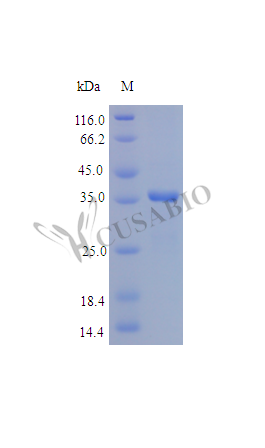Recombinant Human SPARC protein (SPARC) (Active)
CAT:
399-CSB-AP000311HU-02
Size:
100 µg
Price:
Ask
- Availability: 24/48H Stock Items & 2 to 6 Weeks non Stock Items.
- Dry Ice Shipment: No




Recombinant Human SPARC protein (SPARC) (Active)
- CAS Number: 9000-83-3
- Gene Name: SPARC, ON
- UniProt: P09486
- Expression Region: 18-303aa
- Organism: Homo sapiens
- Target Sequence: MSYYHHHHHHDYDIPTTENLYFQGAMGSA+PQQEALPDETEVVEETVAEVT EVSVGANPVQVEVGEFDDGAEETEEEVVAENPCQNHHCKHGKVCELDENN TPMCVCQDPTSCPAPIGEFEKVCSNDNKTFDSSCHFFATKCTLEGTKKGH KLHLDYIGPCKYIPPCLDSELTEFPLRMRDWLKNVLVTLYERDEDNNLLT EKQKLRVKKIHENEKRLEAGDHPVELLARDFEKNYNMYIFPVHWQFGQLD QHPIDGYLSHTELAPLRAPLIPMEHCTTRFFETCDLDNDKYIALDEWAGC FGIKQKDIDKDLVI
- Tag: N-terminal 6xHis-tagged
- Source: E.Coli
- Field of Research: Cancer
- Assay Type: Active Protein & In Stock Protein
- Relevance: Appears to regulate cell growth through interactions with the extracellular matrix and cytokines. Binds calcium and copper, several types of collagen, albumin, thrombospondin, PDGF and cell membranes. There are two calcium binding sites; an acidic domain that binds 5 to 8 Ca (2+) with a low affinity and an EF-hand loop that binds a Ca (2+) ion with a high affinity.
- Endotoxin: Less than 1.0 EU/µg as determined by LAL method.
- Purity: >95% as determined by SDS-PAGE.
- Activity: Yes
- Bioactivity: Fully biologically active when compared to standard. The ED50 as determined by its ability to inhibit the cell growth of Mv1Lu mink lung epithelial cells is less than 3.0 µg/mL, corresponding to a specific activity of > 333 IU/mg.
- Length: Full Length of Mature Protein
- Form: Lyophilized powder
- Buffer: Lyophilized from a 0.2 µm filtered PBS, pH 7.4
- Reconstitution: We recommend that this vial be briefly centrifuged prior to opening to bring the contents to the bottom. Please reconstitute protein in deionized sterile water to a concentration of 0.1-1.0 mg/mL.We recommend to add 5-50% of glycerol (final concentration) and aliquot for long-term storage at -20℃/-80℃. Our default final concentration of glycerol is 50%. Customers could use it as reference.
- Function: Appears to regulate cell growth through interactions with the extracellular matrix and cytokines. Binds calcium and copper, several types of collagen, albumin, thrombospondin, PDGF and cell membranes. There are two calcium binding sites; an acidic domain that binds 5 to 8 Ca (2+) with a low affinity and an EF-hand loop that binds a Ca (2+) ion with a high affinity.
- Molecular Weight: 36.1 kDa
- Storage Conditions: The shelf life is related to many factors, storage state, buffer ingredients, storage temperature and the stability of the protein itself. Generally, the shelf life of liquid form is 6 months at -20℃/-80℃. The shelf life of lyophilized form is 12 months at -20℃/-80℃.
